|
Moon with a View:
Or, What Did Arthur Know… and When Did He Know it?
Part 5
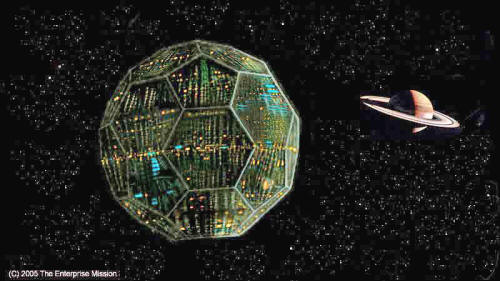
Since “Moon with a View” was originally posted, reaction has been
varied – to say the least!
Some, on reading, have become intrigued. Others are repelled. And
some, typified by this truly wondrous comment on “Coast to Coast AM”
a few nights ago – “This time Hoagland has really walked off the
cliff!” – are simply, as the phrase goes, “out to lunch.”
Fundamental to many criticisms of this theory is the scale of the
construction we’re proposing. These critics see the entire idea of
an “artificial moon” – and one almost a thousand miles across -- as
totally preposterous, mainly because of the size of such an
undertaking. What they forget is that some of these (artificial
world) ideas are actually quite old … and increasingly achievable –
even (as you will see) within the constraints of current technology
and physics!
Their most famous incarnation is, in major part, due to Princeton
University’s Institute for Advanced Studies’ professor,
Dr. Freeman
Dyson. Almost half a century ago, Dyson published a remarkable idea
in the prestigious mainstream journal, Science [Dyson, F. J. "Search
for Artificial Sources of Infrared Radiation," Science, 131, 1667
(1959)] – which described something termed a “Dyson Sphere.”
Dyson
ended his Science paper with the following conclusion:
“I think I have shown that there are good scientific reasons for
taking seriously the possibility that life and intelligence can
succeed in molding this universe of ours to their own purposes
[emphasis added] ….”

In Dyson’s 1950’s calculations, he envisioned huge,
artificial
planets -- built from the “disassembly” of a star’s natural
planetary system, and its subsequent reassembly into a vast number
of smaller, precisely engineered artificial worlds. The resulting
“Dyson Sphere,” in Dyson’s speculations, seemed the largest
artificial structures that an advanced civilization could probably
ever technologically create. And as such, he believed, they might
even be observable light years away, with our “primitive” technology
from Earth ….
In this classic Science paper, Dyson was suggesting that such
extraordinary objects – by literally englobing an entire solar
system in a swarm of artificial “worlds,” thereby trapping almost
all the parent sun’s emitted light and converting it to heat --
would glow brilliantly in the infrared region of the spectrum ...
thus giving themselves away even in Earth’s 20th/21st Century
telescopes, as “artificially modified star systems” (below).

Dyson’s inspiration for this extraordinary idea (as was
Arthur C.
Clarke’s for many of his …) ultimately derived from famed science
fiction writer, Olaf Stapledon – in particular, his 1937 classic,
“Star Maker”:
… As the eons advanced, hundreds of thousands of worlds were
constructed, all of this type, but gradually increasing in size and
complexity. Many a star without natural planets came to be
surrounded by concentric rings of artificial worlds. In some cases
the inner rings contained scores, the outer rings thousands of
globes adapted to life at some particular distance from the Sun ….
Since Dyson’s pioneering publication of his “outrageous” speculation
some 50 years ago, other workers have followed up with a variety of
additional scenarios. All agree that, given enough time and current
technological advancement, even our own terrestrial civilization
could construct the beginnings of a “baby” Dyson sphere (see
schematic - below), perhaps in the next hundred or so years. The key
is in those terms: “time” … and “technological development.”
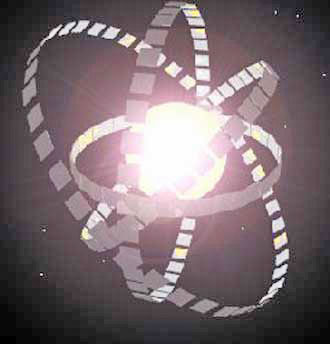
What we’re discussing in this series – Iapetus as a potential
“artificial moon” – is NOT a “Dyson Sphere” by any stretch of the
imagination, but is in fact orders of magnitude easier to engineeringly achieve. I know it will surprise many of our critics
that some of the necessary materials -- and even construction
technologies for such an astonishing assembly -- are already here …
and at least
one U.S. consortium has been formed specifically to
create a similar-scale project -- to be completed in the next 13
years … by 2018!--
“An elevator into space.”
Here’s the basic concept:
To build “an elevator to the stars,” you start building from a
location on the Earth’s equator ... rising vertically until you
reach “geosynchronous orbit” -- some 22,300 miles out. Then, you
send payloads up and down this structure via “climber cars” -- which
would be electrically powered and, on their ascent, being also
accelerated by the increasing centrifugal forces of rotation of the
planet with increasing height, would ultimately achieve tangential
velocities above 22,300 miles capable of launching payloads directly
into orbit (below) ….
Or, as science fiction writer Robert Heinlein once remarked, “Once
you’re in Earth orbit … you're half way to anywhere!”
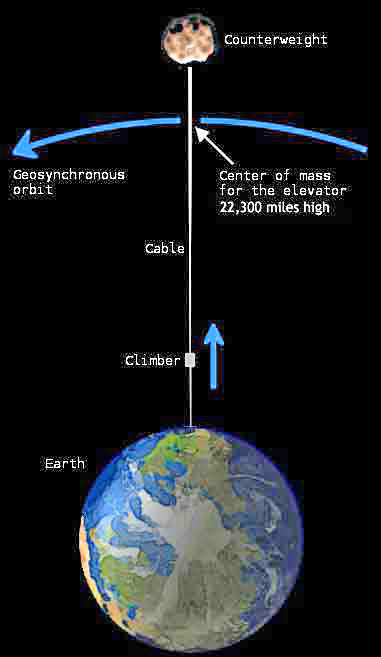
Compared to current, highly primitive methods of getting off this
planet – expendable rockets, the Space Shuttle, etc., which can cost
up to $10,000 per pound of payload launched! – Arthur Clarke once
calculated that one could send a fully grown man to geosynchronous
orbit (and his “22 pounds of carry-on luggage …”) via such an
elevator, for about “a dollars’ worth of electricity …” -- a saving
of ten thousand fold over current rocket-based propulsion systems
(not counting the ~ $10 billion-dollar development costs …)!
The original incarnation of this idea for a “tower into space”
(below) can be traced back to the great Russian space pioneer,
Konstantin Tsiolkovsky, in 1895:
… on the tower, as one climbed higher and higher up it, gravity
would decrease gradually; and if it were constructed on the Earth's
equator and, therefore, rapidly rotated together with the earth, the
gravitation would disappear not only because of the distance from
the centre of the planet, but also from the centrifugal force that
is increasing proportionately to that distance. The gravitational
force drops. . . but the centrifugal force operating in the reverse
direction increases. On the earth the gravity is finally eliminated
at the top of the tower, at an elevation of 5.5 radii of the earth
[22,300 miles] ….
Because of the stupendous mass of such a “tower,” the strength of
existing materials -- even alloyed steels – would soon crush under
their own weight, making it impossible to envision actually building
such a structure above a height of about 4 miles (but even so,
that’s a helluva skyscraper ..!).
Even if composed of 100% diamond (if one could afford it …),
calculation proves that the strongest naturally known material is
far too weak to support itself above about 10 miles ….
Then, in 1960, another Russian – an engineer in Leningrad,
Yuri N. Artsutanov -- published in Pravda a radical “innovation on the
innovation” (below).
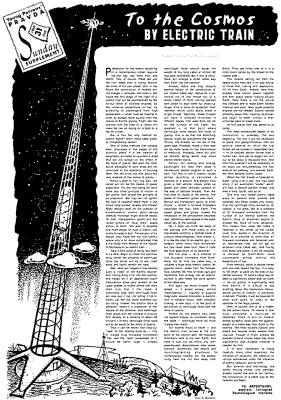
Artsutanov suggested constructing
Tsiolkovsky’s space tower not as a
“tower” at all … but as a literal “skyhook”: starting it in space --
at a “geosynchronous” satellite distance of 22,300 miles out (the
distance whereby a satellite circles the world in exactly the time
it takes the Earth to rotate once on its own axis underneath), and
then lowering the supporting structure (this time, a cable …) the
22,300 miles down to Earth … to an anchor point located on the
equator, directly underneath the orbiting satellite. Another cable,
extended in the opposite direction (beyond geosynchronous orbit)
would support the necessary “counterweight mass” via centrifugal
force … required to hold up the lower cable’s mass against the
Earth’s gravitational attraction.
And, Artsutanov calculated, if the cables were tapered – starting
out quite thick at the geosynchronous height (where the tension
forces would be the greatest), narrowing in both directions as they
approached the Earth and extended in the opposite direction --
suddenly even ordinary materials (if you could lift enough tonnage
into space via other means, like rockets! ...) became strong enough
for use … even in this extraordinary context!
Or, to
quote from Arthur Clarke’s own views on this revolutionary
concept, presented to the Thirtieth International Astronautical
Congress back in 1979:
… with a stepped, or tapered, cable it would be theoretically
possible to construct the space elevator from any material, however
weak. You could build it [out] of chewing gum [!], though the total
mass required would probably be larger than that of the entire
universe. For the scheme to be practical we need materials with a
breaking length a very substantial fraction of escape length. Even
Kevlar 29's 200 km is a mere 25th of the 5000 km goal; to use that
would be like fuelling the Apollo mission with damp gun powder, and
would require the same sort of astronomical ratio [emphasis added]
….

This startlingly simple series of Artsutanov innovations – building
the “elevator” in space, making it a tapered cable … then, lowering
it to the ground from orbit -- suddenly made the whole, “impossible”
Tsiolkovsky’ idea … make sense.
Naturally, space engineers really wanted something a bit stronger
than “Arthur’s chewing gum” to work with. And, in the quarter
century since his address, they’ve finally found it—
Carbon nanotubes ….
In one of the Universe’s greatest “irony of ironies” -- considering
what we now believe the three-dimensional shape of Iapetus to be
(below) – the material that will allow the construction of the
world’s first practical Space Elevator … and a host of other
“impossible” things … turns out to be based on a simple tetrahedral
molecule … composed of carbon: the “carbon nanotube.”
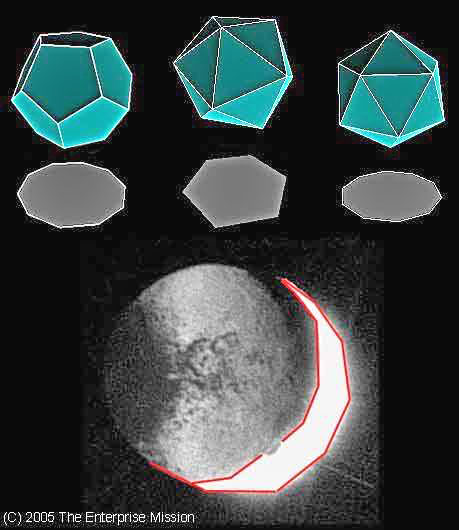
Carbon nanotubes are extremely tiny (the prefix “nano” comes from
their dimensions, about a billionth of a meter -- one nanometer --
wide), rolled-up, three dimensional carbon tubes, made of a
hexagonal graphite lattice -- first cousin to two other forms
(“allotropes”) of carbon (below): the well-known diamond … and
something relatively new, called a “Buckminsterfullerene.”
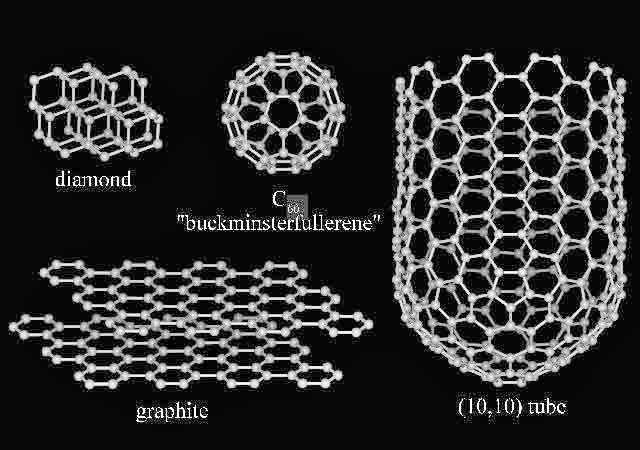
The latter -- also known as “buckyballs” – are C60 molecules
discovered serendipitously by a team at Rice University, led by
Dr.
Richard Smalley (Nature 318, 162) in 1985 (below). Named after
R.
Buckminster Fuller, inventor of the geodesic dome (discussed in
“Moon with a View” - Part 2), the “fullerene’s” 60 carbon atoms (!)
are arranged spherically, as 12 pentagons and 20 hexagons (below),
in the most symmetrical molecular form known.

Then, six years after fullerenes were first synthesized in Smalley’s
Texas laboratory, the “nanotube” version of this fascinating
molecule was
independently discovered -- by Sumio Iijima, in Japan
in 1991.
Extensive laboratory work around the world since these serendipitous
discoveries, exploring the physical parameters of these newest forms
of carbon, has confirmed truly extraordinary properties. According
to a
1999 report from the University of Michigan—
… nanotubes, though very much still in the infant research phase,
show many promising, world changing applications. Nanotubes have
shown to be very strong materials. The Young’s modulus, a
representation of a material’s strength, has been computed to be on
the order of 1.2 Terra Pascals, 6.25 times that of steel [3]. Based
on this, Professor Richard Smalley, a leader in the nanotube field
and Nobel laureate for his buckyball research, has stated that
nanotubes are at least 1000 times stronger than steel rods of the
same size. [below]. Coupled with the fact that nanotubes are
one-sixth the weight of steel, some fantastic structural,
mechanical, and materials applications are currently being
researched. These ideas include composite structures, super strong
cables, small nanogears or nanomachinary, and a possible storage
medium for chemicals [emphasis added] ….
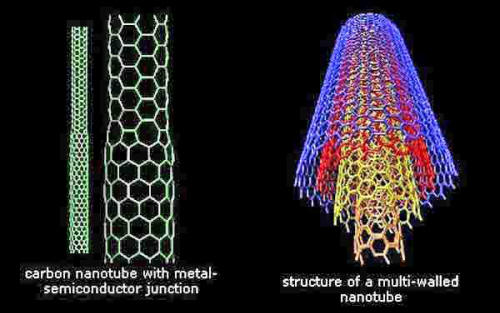
So, after “only” a century of looking, the engineers had indeed
found a material “somewhat better than chewing gum” … that would
finally make a real “elevator to the stars” (below) ….
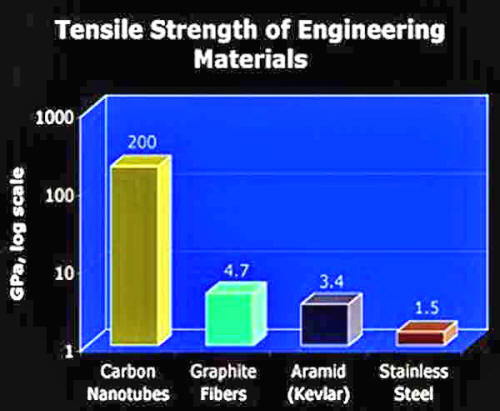
What’s truly extraordinary about all this is that a host of teams,
worldwide – including, as noted earlier, one
U.S. association of
high tech companies and architectural firms -- are now in a feverish
competition to actually be the first to build this astonishing
contraption. The pacing item at this point seeming only to be
convincing someone to invest a “measly” $10 billion dollars to get
in on the (sorry…) literal “ground floor.”
(Later, here on Enterprise, we’ll consider separately these
audacious, rapidly accelerating Space Elevator plans – which, if
successful, could revolutionize human access to the solar system –
and thus future history itself. And, we’ll share a remarkable
“hyperdimensional surprise” we have discovered … which will both
assist – and challenge -- these Space Elevator engineers when they
begin actual construction ….)
So … what does all this have to do with Iapetus?
Simple.
Obviously, if current materials science has developed a technology
capable of constructing a single space structure, raised against
Earth’s gravity … and
over 60,000 miles in length (a 22,300
mile-high cable, stretching from Earth to geosynchronous orbit, plus
the additional length for the required counterweight …), that same
technology could someday easily create other “large space
structures.”
It’s only a matter of developing the appropriate
techniques for “spinning” the high-strength nanocables or
“nanorebar,” out of nanotubes and buckyballs -- coupled with
development of the necessary computer-controlled, robotic assembly
techniques for remote manufacturing/construction in high orbit ...
or … in orbit around a distant source of the critical raw material …
carbon.
Which, is far more available in the outer solar system than close to
home ….
And, as stated, one U.S. consortium –
the Liftport Group -- even has
a “countdown clock” now posted on their website … literally
counting down the days, hours, minutes and seconds, until the first
terrestrial Space Elevator is successfully created … and opened for
delivery of customers and cargo to high orbit!
COUNTDOWN TO LIFT: April 12, 2018

If a handful of individuals on this planet -- at the very beginning
of the 21st Century -- can realistically envision building such a
revolutionary system by 2018, what could an ancient space-faring
civilization such as we’ve proposed for Mars … countless millennia
ahead of us -- scientifically and technologically -- have been able
to achieve?
In other words: the biggest impediment to taking our Iapetus
proposal seriously – the scale of a thousand-mile-diameter “moon” –
pales into insignificance (with even slightly more space expertise),
compared to current plans aimed at creating a literal, “60,000
mile-high skyhook to geosynchronous orbit” … and in less than 20
years!!
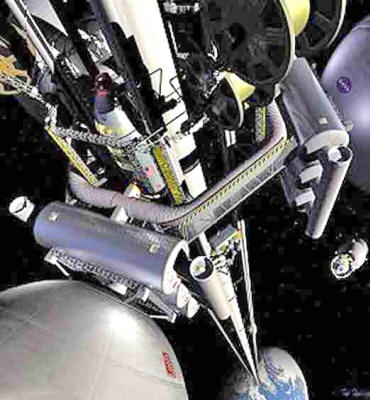
In addition to being an elegant solution to the technology of how
Iapetus was formed, the choice of carbon nanotubes and buckyballs
for its construction would immediately address (and answer!) a
variety of classic problems that have baffled the astronomical
community regarding Iapetus’ appearance for the last three hundred
years – starting with the unique “light/dark dichotomy” of those
opposing hemispheres (below).

In addition, the use of such ultra-high-strength carbon would
forthrightly address the startling and baffling new questions raised
by Cassini’s recent fly-by, beginning with–
The “moon’s” amazing geometric form.
If Iapetus is a “tetrahedral message” – a message redundantly
communicated by the specific placement of key features on its
surface (the “ring basins,” etc.), compounded by its very strange
orbit around Saturn, at ~ 60 radii away and 15-degree inclination to
the rest of the Saturnian moons (which, as
George Haas reminded me,
when divided into 60, is another numerical code for the four
vertices of a tetrahedron!) -- then what better means to underscore
that message, once again ... than to create the “moon” in the very
shape of the carbon molecule used in its construction—
In actuality, one of the 13
Archimedian Solids: a “truncated icosahedron!”
(below)
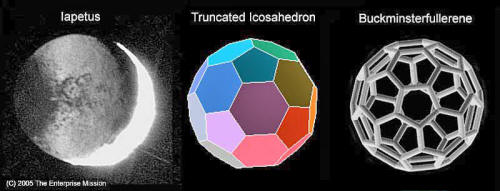
In other words -- a 900-mile-wide, C60 “fullerene?!”
Looked at in a larger context, creating a moon-sized “truncated
icosahedron” would simply be the ultimate means of saying
“five-sided/six-sided symmetry is crucially important in the
Universe ….”
As Erol Torun discovered and decoded at Cydonia in 1988, the major
artificial structure on that landscape – the so-called “D&M Pyramid”
(below) – also neatly communicates this
identical mathematical
“message”: the key relationship between five-sided and six-sided
geometry in the “real” world. The loose “translation” of such a
“message” (in Cydonia’s tetrahedral/hyperdimensional context):
“The ‘relatedness’ of the physics of six-sided symmetry in the
natural world (crystals, energy flow, etc.) to the biology of
five-sided forms, is crucial to understanding life itself ….”
And life, as we currently see it, is solely based on
carbon ... the
quintessential “tetrahedral” molecular form.
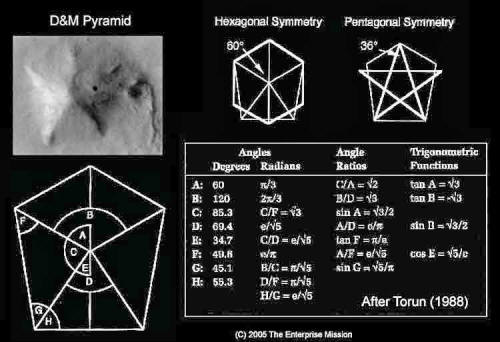
In other words, the real message is …
“Life (five-sided symmetry)
cannot exist … without a hyperdimensional (six-symmetry) connection
….”
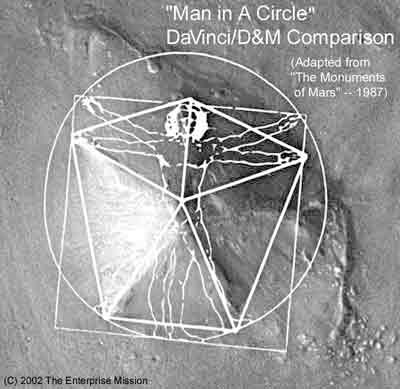
The combination of this same “message” in Iapetus – in one, much
larger solar system object -- could be another shorthand way of
saying:
“Here, in this object, is embodied both – the biology of a
living, artificial world … created and maintained via tetrahedral
(hyperdimensional) physics. Come find out what else it means …”
This commonality, of course, is yet another indicator that the
source of this “repeating solar system message,” somehow, is
connected with what we’ve already found and decoded … back on
“Mars.”
But, besides being uniquely supportive of the other “tetrahedral
clues” embodied in Iapetus -- the entire “moon,” as a gigantic
fullerene (!) – this recursive statement could also be seen as
redundant communication of the unique materials making up this
“moon.” In other words, a back-up message: to underscore to any
materials scientist, even viewing from a distance (below) -- “This
place is obviously artificial!”
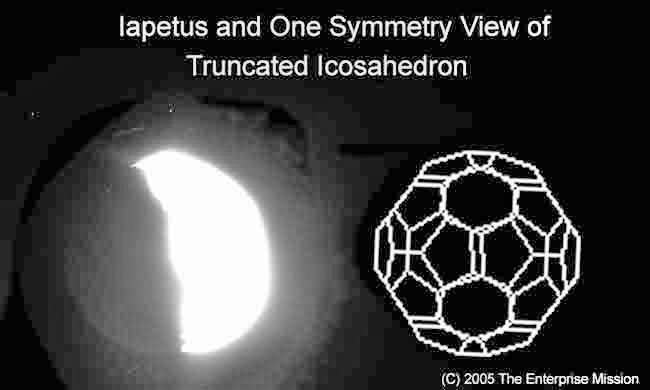
If whoever left this increasingly remarkable object “parked” in
orbit around Saturn wanted such a set of signatures to be
recognizable -- even after the erosion of literally millions of
years -- they would have needed precisely this degree of “redundancy
and convergent clues,” potentially linked to other “messages” left
in other places in the solar system … to make the “message” real.
Culminating with this astonishing result—
Take the specific geometry that now seems to shape
Iapetus – a
truncated icosahedron, a duplicate of the “C60 fullerene.” Multiply
it by the number of radii Iapetus is orbiting away from Saturn (60
…). And discover—
360 -- the exact number of degrees in a full circle/orbit of this
extraordinary “moon!”
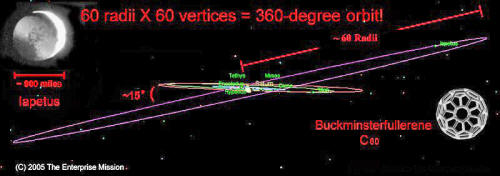
The odds against these precise, interrelated “tetrahedral” numbers
constantly recurring in one “moon” -- each neatly “encoded” in the
very size, shape, distance and orbital inclination of Iapetus by
“sheer coincidence” -- are literally now overwhelming!!
The clincher is the recursive relationship between Iapetus’
measurable, remarkable macro-fullerene appearance ... and the
extraordinary physical properties of the microscopic carbon nanotubes that, in our model, someone had to use to build it!
According to Nobel Laureate Dr. Richard Smalley, writing for the
American Scientist online:
… nanotubes are [nothing more than] giant linear fullerenes. A
fullerene, by definition, is a closed, convex cage molecule
containing only hexagonal and pentagonal faces. (This definition
intentionally leaves out possible heptagons, which are responsible
for the concave parts and are treated as defects.) Like any simple
polyhedron, a fullerene cage or a nanotube satisfies Euler's theorem
(earlier proved by Descartes) relating the number of vertices (here,
carbon atoms), edges (covalent bonds), and faces: v - e + f = 2. If
the number of pentagons is p, and the other (f - p) faces are all
hexagonal, then the doubled number of edges (each edge belongs to
two faces) is 5p + 6(f - p), which also equals the tripled number of
vertices (each trivalent carbon is shared by three adjacent faces).
A simple accounting then yields p = 12, and therefore a nice,
defectless nanotube must have exactly 12 pentagons, the same dozen
as in the buckyball! The strict rules of topology impose this family
trait on all fullerenes. An even more obvious trait the nanotubes
inherit from another ancestor, graphite, is a hexagonal pattern on
their walls. Figure 4 illustrates this by showing two possible ways
of constructing a nanotube from a precursor form of carbon [emphasis
added] ….
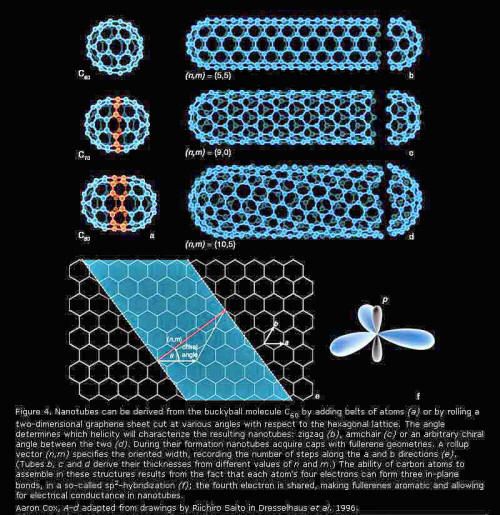
With this identity established, it is a reasonable
speculation/hypothesis that the prime reason why the current surface
of Iapetus is repeatedly collapsing, and on a variety of scales in
repeating hexagonal and pentagonal patterns (below), is specifically
because of this fractal, meteor battered, underlying
hexagona/pentagonal carbon nanotube construction!
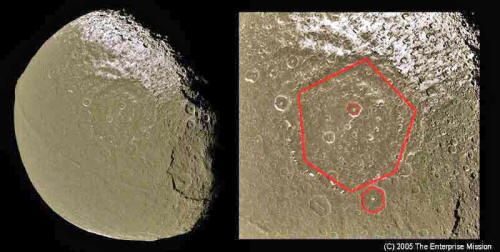
So, how does the presence of this “buckytube” material (the other
name by which carbon nanotubes are known …) address the major
three-hundred-year-old mystery of Iapetus’ “light/dark dichotomy?”
Pure carbon is dark … very dark. In fact, in certain forms, it’s the
darkest substance known.
For decades, via telescopic “spectrophotometry” (and now via
Cassini’s own VIMS), the dark substance on the front of Iapetus
has
been attributed to “some form of hydrocarbon.” Which is just another
way of saying “carbon … with something else mixed in.”
In their 1985 experiment, which accidentally discovered fullerenes,
Smalley and company were using a high-power laser, fired at a
rotating disc of pure graphite (below), in an effort to blast off
“long-chain hydrocarbons ….” Instead, they discovered a new, pure
allotrope of carbon – the buckyball.
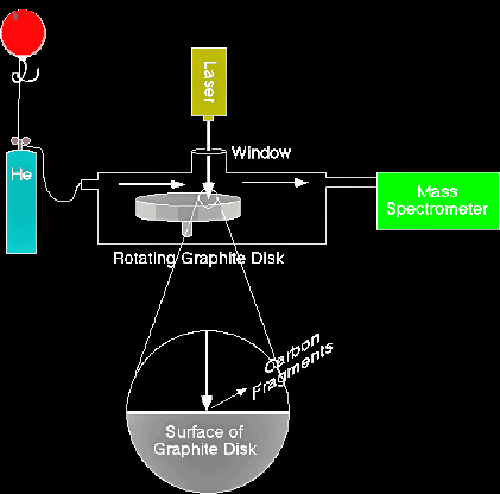
The operative agency was “heat.”
The heat from the focused laser beam broke the graphite bonds
(above), and allowed the most stable form of carbon – C60 fullerenes
– to form. The problem: the process was extremely inefficient; the
amount of C60 produced in the 1985 experiments was very small.
Smalley calculated that, even if the set-up was run ten years
non-stop, it wouldn’t produce enough fullerenes to coat the bottom
of a test tube (a few milligrams, at most)!
However,
other research groups soon discovered processes for making
fullerenes that were far more efficient:
… the next scientific breakthrough came in 1990 when a
German/American group and the Sussex group independently showed that
C60 could be made in gram quantities using a carbon arc. The
technique is essentially very simple; if a voltage is applied to two
carbon rods, (just touching), an arc will develop between them. If
the arc is maintained in helium or argon (instead of in air) clouds
of black smoky carbon soot are produced. It turns out that at the
correct arc temperature and gas pressure up to 10 % of the black
soot is C60. Also present in the soots are 1% C70, and smaller
quantities of larger fullerenes [emphasis added] ….
Note the redundant use of the term “soot.” That’s what carbon forms
in these experiments: a pitch black amorphous carbon residue ... of
which only about 10% are fullerenes. Now, what is the distinguishing
hallmark of the front of Iapetus?: its carbon-black/deep reddish
surface (about 3-4% reflectivity) -- consistent with a LOT of carbon
fullerenes … mixed in (coated?) with “something reddish” … and a lot
of “soot.”
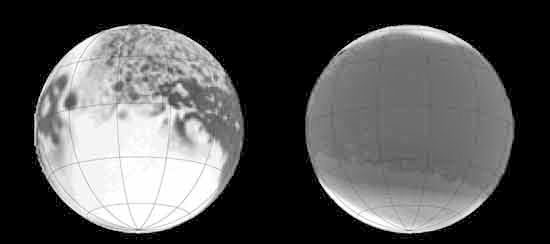
Assuming fullerenes and nanotubes are, indeed, the main structural
component of Iapetus – because of their extraordinary tensile
strength, ease of mass production, natural abundance of carbon in
the outer solar system, etc. -- what would this model predict
regarding the specific origin of the infamous “light/dark dichotomy”
(above)?
The standard planetary composition for Iapetus, based on both
spectral observations of the light side, and the insitu density
measurements carried out by the Voyager/Cassini fly-bys, is that
this Saturnian satellite is just another icy moon. Telescopic
surface spectral scans have repeatedly revealed the
classic
absorption pattern of frozen water, and
the planned Cassini
spacecraft density measurements, carried out in December, 2004 –
revealing <1.1 g/cc – amply confirmed this previously measured
density from Voyager.
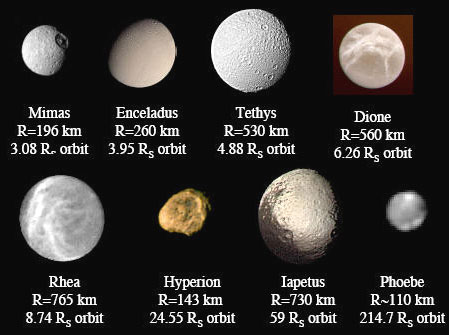
But … is this really what Iapetus is made of?
If this object is, indeed, an artificially constructed “world” --
whose interior frame, if not actual surface “skin,” is fractally
composed of carbon nanotubes, and whose interior is mostly hollow
“rooms” ... once filled with air, machinery, and other essentials
for a totally enclosed biosphere -- then the actual bulk structural
material could have a much higher specific gravity (density) than
water ice, and yet Iapetus’ surface appearances could still give the
misleading impression of “just another icy moon” ….
How?
Over time, as repeated major impacts punctured through its “skin,”
interior volatiles from the essentially hollow, pressurized interior
– particularly water vapor – would have been explosively released to
space. These water molecules would have immediately condensed on the
coldest surfaces available ... which, at Saturn’s distance from the
Sun and frigid temperatures, would have been the outside of this
apparent “moon!” This would have created, with each impact, local
venting and re-condensation of spectrally pure ice – until most of
the interior water vapor in the formerly contained atmosphere was
“cold trapped” all across the surface of Iapetus!
Eventually, the last sealed rooms in the interior would have been
inevitably breached … releasing their last remaining air. From that
point on, as this derelict “moon” continued orbiting Saturn – one
hemisphere synchronously facing its orbital direction, the other
“protected” to the rear -- the constant “sandblasting effect” of a
million million meteor impacts … over literally millions of years …
would have preferentially vaporized the vented coating of thin ice
from the forward-facing hemisphere--
Selectively re-exposing the original black, carbon nanotube surface
hiding underneath – through a geometrically-determined elliptical
erosion pattern (via longitudinal physical
libration) -- stretching
across that leading hemisphere … and partially beyond (see also,
time lapse sequence -- below)!
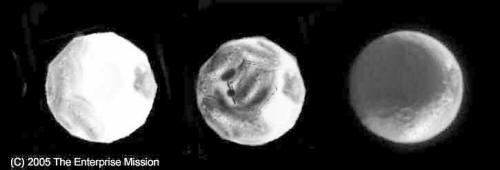
This -- in the artificial model -- is the real explanation for the
three-hundred-year-old mystery of the “dark side of Iapetus!”
The underlying carbon-rich material, via secondary trajectories (in
the 1/40th Earth gravity of Iapetus’ surface) would also have
“dirtied” the remaining ice, even on the protected opposite
hemisphere -- via ballistically transported carbonized debris from
impacts on the front. And, in addition to revealing the original
blackened surface there, this incessant micrometorite erosion would
have inevitably worn away some of the elevated vertices and edges of
the original “moon” … ultimately producing the muted “truncated isocahedron” visible today ….
In this model, the “dark ellipse” -- contrary to mainstream
speculations -- is not a deposit of “dark stuff from Phoebe” lying
on a bright, white, icy surface … but rather, is the
geometrically-determined result of a long-term erosion (and
contamination) of a previous ice deposit vented from the interior
biosphere … preferentially eroded via orbital dynamics ….
These ideas, of course (the artificial aspect notwithstanding), are
the exact antithesis of the current leading mainstream models for
Iapetus. According to
Bruce Moomaw, a well-known science writer
covering Cassini:
… the "exogenous" (outside-source) theory is favored, because nobody
can come up with a good explanation for why Iapetus' interior would
vomit up such dark material when none of Saturn's other moons shows
a trace of it [emphasis added] ….
And, unless they seriously investigate this
artificial model … they
never will!
Our idea, of course, also instantly explains why even at the
kilometer-scale resolution of the December, ‘04 fly-by, Cassini saw
NO bright impact craters (or bright rayed craters) anywhere across
the dark ellipse -- “punching through” the overlying dark material
(the mainstream model …) to reveal the bright, primordial ice lying
down below.

Why …?
Because—
That “icy landscape” doesn’t exist!!
Iapetus’ real surface (underneath even the brilliant, “ice-covered,
trailing hemisphere,” and still surviving “polar caps”) is composed
of successive shells of meteor-battered, black carbon nanotubes and
fullerenes … which is precisely what Iapetus’ shape has also been
trying hard to tell us!
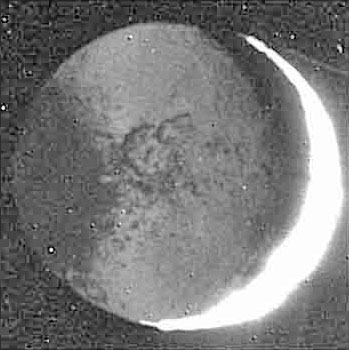
Serious support for this idea can be seen in other
Cassini images
(below), which have been returned by distant fly-bys since mid-2004;
if one looks carefully at this several month-long sequence, with the
sun coming from the right, it is clear that between the bright white
trailing hemisphere (image, right) and the “dark ellipse” (image,
left), there is a serious topographic “step” – augmented in places
by major impact scars -- fascinatingly consistent with several miles
of the front” of Iapetus having been literally blown off and eroded
away … either by the intense “blastwave” of debris from the exploded
Planet V sweeping across Saturn’s distant orbit … or … by millions
of years’ exposure to an unceasing meteoric “rain” ….
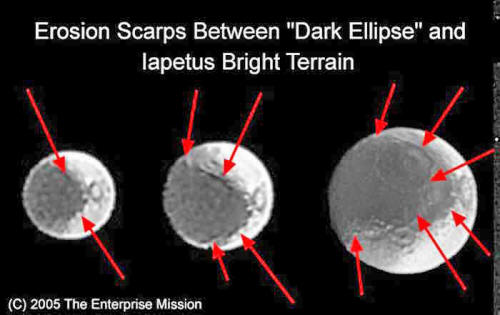
This “asymmetric erosion model” -- revealing this
black carbon
surface underneath Iapetus’ thin covering of ice -- is also totally
consistent with the new, overexposed Cassini images ...
which
close-in (below) reveal a remarkably geometric terminator on some
regions of the more protected trailing hemisphere of this amazing
“moon” ….
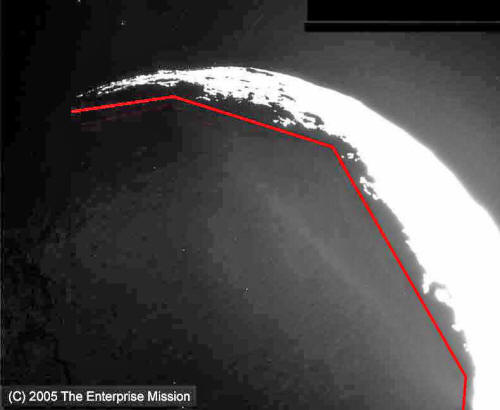
In other words -- a 900-mile-wide, C60 “fullerene?!”
Amazing as it may sound, there is actual human precedent for this
idea: embodying the geometry of the material used in constructing a
particular monument … in the monument’s final macro-geometric form!
The most striking example of this practice (before Iapetus, that is
…) was brought to my attention several years ago, by my good friend
and colleague,
Stan Tenen.
Stan pointed out that the Great Pyramid, located on the Egypt’s Giza
Plateau, is composed primarily (except for a bit of granite “here
and there” inside …) of another carbon-compound known as “calcium
carbonate” (CaCO3). Most folks know it better as “limestone.” It’s
also known as “calcite” -- the rock type that forms huge layers of
the 70-million-year-old strata making up the Plateau, as well as
much of the rest of Egypt -- extending east, all the way to
Indonesia ….
Huge blocks of calcium carbonate were quarried (not far from the
Plateau …), and carefully shaped into the “six million tons of
limestone blocks …” that were then used to create a structure over
750 feet on a side and almost 500 feet high: the legendary
Great
Pyramid itself.
Stan, both to me and on the radio, noted that if you just look at
the exterior geometry of the Great Pyramid (below), shaped visually
by the three angles it presents from any one side -- the 76-degree
angle at the apex, and the two 52-degree angles where it touches the
ground at the base -- you will actually be looking at a giant
replica of the same internal angles of the calcium carbonate crystal
of which it is composed!!
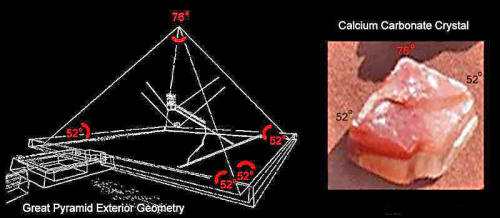
In other words: the Great Pyramid – exactly like Iapetus in our
scenario – is a demonstrable giant replica of the precise material
that someone used to build it!
Looked at in a larger context, creating a moon-sized “truncated icosahedron” would simply be the ultimate means of saying
“five-sided/six-sided symmetry is crucially important in the
Universe ....”
Finally, a major, serendipitous aspect of this model is a completely
integral explanation for Iapetus’ latest, fascinating mystery --
“the Wall.”
According to the 2005 Lunar and Planetary Science Conference ISS
Team paper, covering the last six months of Cassini’ observations of
Iapetus:
… these data led to the discovery of the enigmatic "bellyband" of
Iapetus, a ridge or chain of mountains that follows Iapetus' equator
precisely over at least 1300 km [3]. The highest measured peak rises
~20 km over the surroundings, or ~28 km over a reference radius of
718 km [10]. However, as in Voyager data [8], a good reference
ellipsoid cannot be found because of the unusual irregular shape of Iapetus ….
The ridge coincides with the faint equatorial streak observed in the
October [2004] and even July data. The slope of the southern flank
achieves a gradient of up to 20°, the northern flank ~30°. The ridge
itself appears to be located on a broader bulge, extending a few
hundred km in southern and northern directions [emphasis added]...”
Based on these early measurements by the
Cassini Team and certain
structural considerations of the artificial model, it seems highly
likely now that “the Wall” (below) is NOT simply a feature sitting
on Iapetus’ surface – as many have speculated ... extending more
than 12 miles above the surrounding plains -- but rather—
The remains of a deep, massive “equatorial reinforcing ring” --
which was used to literally join the two hemispheres of this
“artificial moon” together!
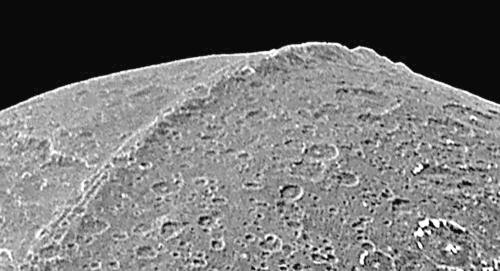
The fact that we see it now as a sharply elevated “wall,” in this
scenario, is only due to its significantly more massive, more
durable construction -- compared to the surrounding “landscape.”
Only for this reason, in my estimation, has this unique solar system
feature been able to resist, even partially, the continual
sandblasting and larger impacts (above) -- which have demonstrably
destroyed other parts of it in places, as well as erode the
surrounding “landscape” on both sides … down to a depth of several
miles!
Echoing the ISS Team description--
… the ridge itself appears to be located on a broader bulge,
extending a few hundred km in southern and northern directions
[emphasis added]--”
This would indicate that Iapetus’ original surface, paralleling “the
Wall,” was also reinforced (more layers?) … leaving a broad,
erosion-resistant “bulge” extending north and south of the
reinforcing “Wall” itself (below) ….
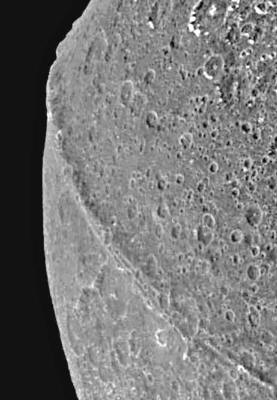
Also, notice – as the surviving segments of “the Wall” arc around
Iapetus’ equatorial circumference (above) -- it appears to be a
single band in some places … and as much as three, parallel bands in
others.
This, I believe, is not only additional, blatant evidence of
artificiality (nature does not like “straight lines” ... especially,
multiple straight lines that run parallel for several hundred
miles!), but perhaps a major clue as to an additional reason (beyond
structural reinforcement) for “the Wall’s” precise construction … on
(and beneath) the Iapetus’ equator.
We’ll explore this possible technological use – in addition to
structural reinforcement -- later on ….
But before we leave the subject, we should make at least one firm
scientific prediction regarding this unique feature for the next
Cassini fly-by ... whenever that occurs.
If “the Wall’ is the leading hemisphere’s meteor-eroded remains of a
former equatorial construction… then, we should NOT expect to see
much visible evidence for its presence in the trailing hemisphere --
except, perhaps, where large impact craters have partially excavated
portions of the buried sections!
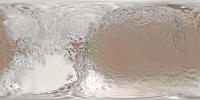 In this “erosion model,”
the Wall – and the dark ellipse so
intimately associated with it (see
Steve Albers’ Iapetus Mercator
Map - below) – are the unique products of the micrometeorite erosion
of the original surface across the leading surface of this “moon.”
Where that erosion has not occurred to this degree (in the trailing
hemisphere), only subtle surface evidence of such an “equatorial
ring” – in actuality, completely circling Iapetus -- should now be
visible beneath the original ice-coated geometric surface …. In this “erosion model,”
the Wall – and the dark ellipse so
intimately associated with it (see
Steve Albers’ Iapetus Mercator
Map - below) – are the unique products of the micrometeorite erosion
of the original surface across the leading surface of this “moon.”
Where that erosion has not occurred to this degree (in the trailing
hemisphere), only subtle surface evidence of such an “equatorial
ring” – in actuality, completely circling Iapetus -- should now be
visible beneath the original ice-coated geometric surface ….
Additional, high-resolution Cassini imagery of the rest of Iapetus
should be able to definitely put this prediction to the test.
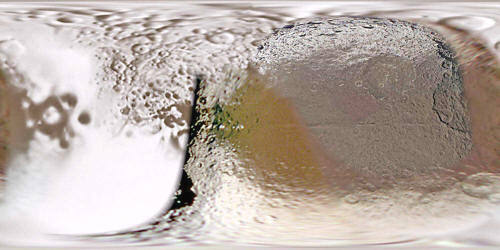
Which brings us back to the unique reddish color and extremely low
albedo of the heavily eroded, “dark ellipse” itself.
In our scenario, the exposed, highly battered layers of Iapetus,
centered north and south precisely on “the Wall” (above), should be
dead black – a mixture of the original reinforcing carbon
architecture, and the smashed debris of trillions of dissociated nanotubes and fullerenes, turned to ordinary “soot” by countless
megayears of high-temperature impacts on the leading hemisphere.
However, historical spectral observations of the dark ellipse (and
now, Cassini’s color imaging) are significantly more intriguing;
according to
many leading, decades-old papers—
… spectrophotometry of the Saturn satellite
Iapetus in the 0.3-1.0
micron wavelength range shows the dark hemisphere to be very red,
similar to a few asteroids and the earth's moon, but with no
spectral features implying olivine or pyroxene [ordinary “rocks” -
emphasis added] ….
And, as noted earlier, at least one group of authors -- in
a 2001
paper published while Cassini was in the early stages of its
seven-year odyssey to Saturn -- believed they had finally solved the
three-hundred-year-old mystery of Iapetus’ dark ellipse using large
telescopes from Earth, as:
… an intimate mixture of water ice, amorphous carbon, and a
nitrogen-rich organic compound … Observations in this spectral
region have not revealed this mix of material on any other object
observed thus far [emphasis added] ….
The first part of their observational fit is, of course, precisely
consistent with our nanotube/fullerene model! The problem comes with
the rest of their attempted match: the mystery of the additional
“nitrogen-rich … organic compound.”
In a recent interview, investigative journalist Linda Moulton Howe
managed to elicit some very telling comments about the composition
of the dark ellipse from Bonnie Buratti, Principal Scientist,
Division of Earth and Space Sciences, NASA's Jet Propulsion
Laboratory (JPL), in Pasadena, California. Buratti is a member of
the Cassini VIMS Team, and
has presented to colleagues in the last
few months preliminary Iapetus composition estimates from the recent
spacecraft fly-bys. Here are a couple of intriguing comments she
made, in response to Linda’s questions regarding the current Cassini
observations of Iapetus:
… it looks like the bright side [of
Iapetus] is primarily water ice
– [but] not fresh water ice, because the reflectivity (although it
is bright, it reflects about 60% of the radiation) … [is] kind of
like dirty snow. So, we think there is something else there, other
than pure water ice ... there is some organic material [there], some
carbonate material that's rich in carbon, hydrogen, oxygen and
nitrogen. Kind of crud; I think you could call it crud.
The dark side, though, has very little water ice. It's primarily
minerals and various organic material(s)…. We seem to [also] see a
mineral that is iron- bearing in the infrared [emphasis added] ....
Now, readers with good memories will remember that in
Part 3 we
discussed ferro-electric coatings (“paint”) -- like “carbonyl iron
ferrite” -- applied to the F-117 to make it “stealthy.” And, in the
February, 2005 issue of Scientific American, in an article called
“Nanotubes and the Clean Room,” by Gary Stix, the following comment,
regarding an unwanted side effect of current nanutube manufacturing
techniques, was casually made—
… nanotubes, purchased from bulk suppliers, are a form of high-tech
soot that contains a residue that averages 5 percent iron, a
contaminant whose very mention can produce involuntary tremors in
managers of multi-million-dollar clean rooms. The Nantero team
devoted much of its early development [of the new nanotube chip] to
devising a complex filtration process to reduce the amount of iron
to the parts-per-billion-level [emphasis added] ….
Given that the natural moons of Saturn formed in a region of the
solar system essentially devoid of iron -- the ultra-frigid realm of
the outer solar system, where the condensation of ices from the
Saturn nebula far more readily occurred – the presence of copious
amounts of free iron on the surface of Iapetus (but missing on the
other Saturnian satellites) presents another serious impediment to
Iapetus’ formation and evolution as “just another moon” ....
Unless—
1) what Burris and her colleagues are seeing in the VIMS data of
Iapetus is an iron contaminant of
the nanotube manufacturing process
used in Iapetus’ original construction
2) the anomalous iron is
part of a ferro-electric coating, deliberately applied to Iapetus
(along with its intrinsic geometric shape – below) -- to make it …
stealthy!
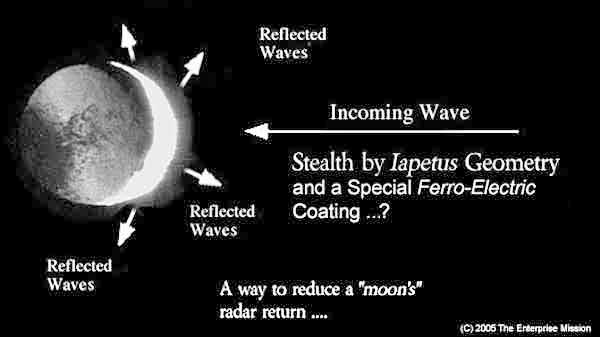
The implications of a deliberately stealthy Iapetus – constructed
with both the precise geometry required for reflecting radar waves
away, as well as a dead black, iron-based coating for absorbing the
remaining visible and radio electromagnetic energy – are definitely
non-trivial in this context! Including—
The possibility that Iapetus was not a “rescue ark” at all, but in
actuality—
A world-size warship!
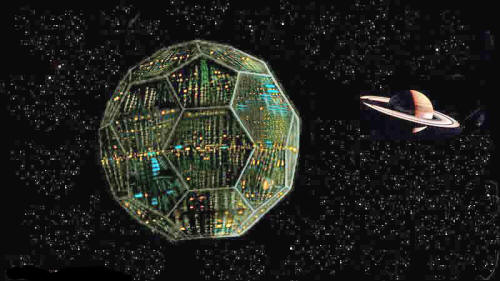
This, of course, would immediately raise the very troubling
possibility that the demise of Planet V -- and the environmental
destruction of the entire inner solar system as a consequence,
including Mars itself -- was not a naturally-occurring catastrophe
at all ….
Is this, indeed, the origins of that chilling and peculiar
mythos …
which has, for millennia, equated “Mars” – where our ancestors in
this scenario ultimately came from -- with a bloodthirsty “god of
war” ….?
If any of this is true ... it could now make this striking
comparison (below) far more than just a metaphor ….
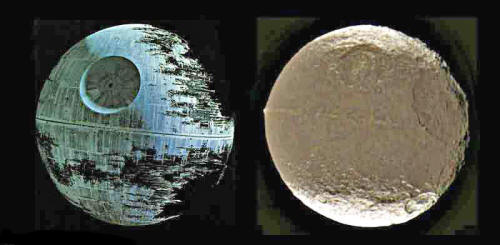
Either prospect is extraordinary – Iapetus as “ark” … or Iapetus as
"deathstar” -- and opens up major new avenues for using Cassini’s
on-board radar during the next fly-by to determine critical
dielectric parameters regarding the true composition of Iapetus’
surface -- which could ultimately allow scientific determination of
its possible artificial origins … if not which “design hypothesis”
is true ….
Mainstream defense research into “buckytube” dielectric and
electromagnetic properties – and their application to current
stealth technology -- leave no doubt that, if
Iapetus is truly an
artificial shell structure, composed of trillions of manufactured
carbon nanotubes underneath its remaining covering of ice, their
“anomalous” (compared to natural absorption models) radar signature
from Cassini should ultimately tell us.
Maybe – given JPL’s obvious reticence to releasing the results of
its existing Cassini Iapetus’ radar observations -- they already
have ….
Which brings us to the other curious observation that JPL’s Buratti
talked about: the presence in the Cassini Iapetus spectra of
“organics.” Where – in our artificial “moon” scenario -- would those
organic molecules originate?
Unfortunately, looking at the global Iapetus images taken by Cassini
last December – with the enormous impact scars still etched across
its surface – the answer now is all too obvious:
The organic component of the exposed “dark ellipse’ – and thus, by
inference, the rest of the ice-covered blackened surface of Iapetus
… still hiding underneath its frozen layers of ancient inside air –
could be direct clues to the incineration, explosive decompression
and subsequent “cold trapping” on the surface … of its former
organic biosphere inside!
The magnitude of such a potential cosmic cataclysm boggles the
imagination.
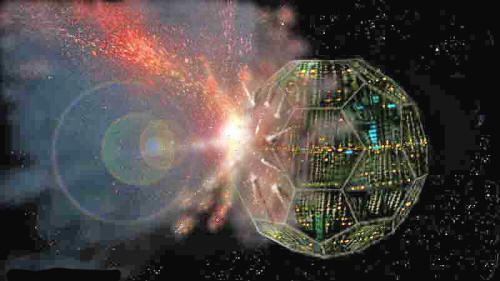
The thought of countless beings – along with their entire rich
interior ecology -- destroyed in one hellish moment … by the inferno
of the deliberate impact of one (or more) asteroid-sized objects
into Iapetus … releasing a hundred million megatons or more … is
almost unimaginable.
But, if true, the lasting signatures of this world-shattering
catastrophe -- the “intimate mixture of water ice, amorphous carbon,
and a nitrogen-rich organic compound …” – would indeed be spread for
all eternity across the surface of such a shattered “world”--
Creating an immortal “winking” epitaph across the solar system …
down through the countless millions of ensuing years … written in
the mysterious “dark ellipse” that now forever scars the surface of
this frozen tomb -- if not the psyche of the few who may have
managed to escape ... to start new lives in the dim pre-history of
our own world ….
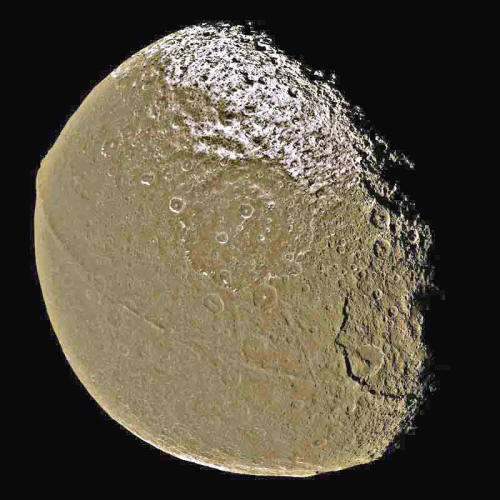
Click Here for Part Six
→
|







































